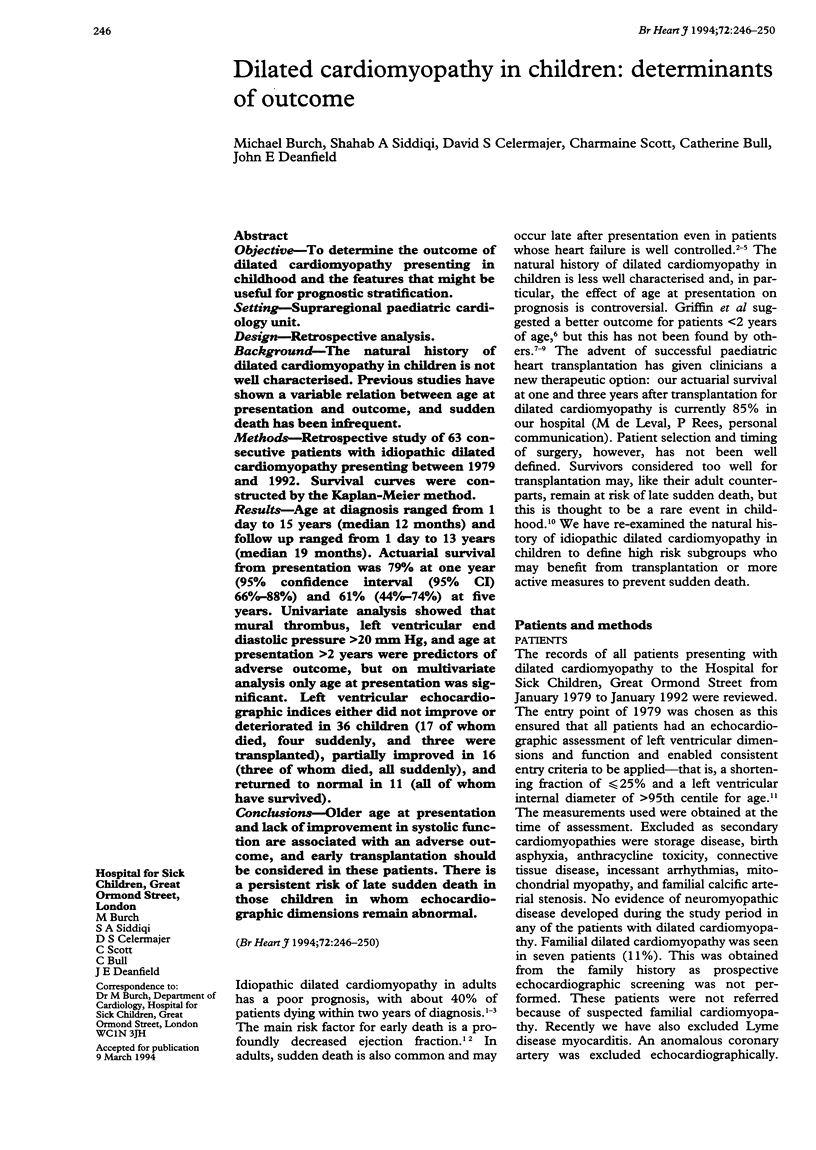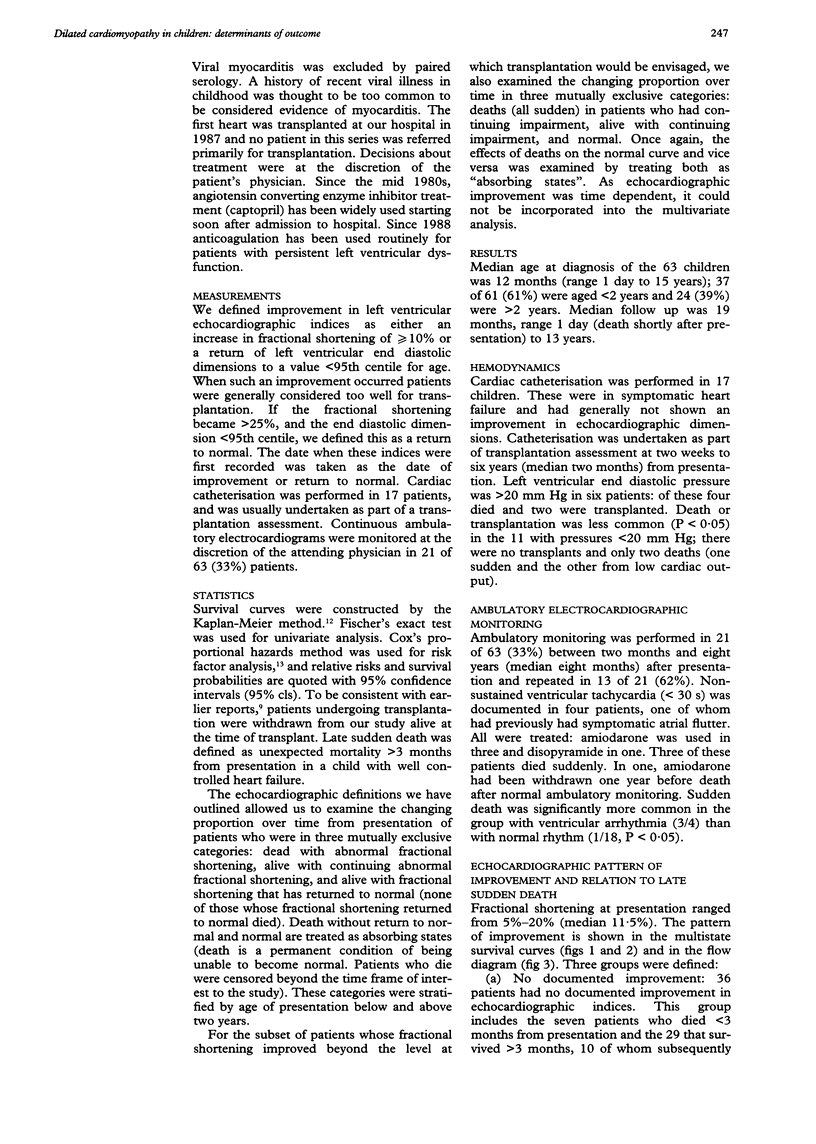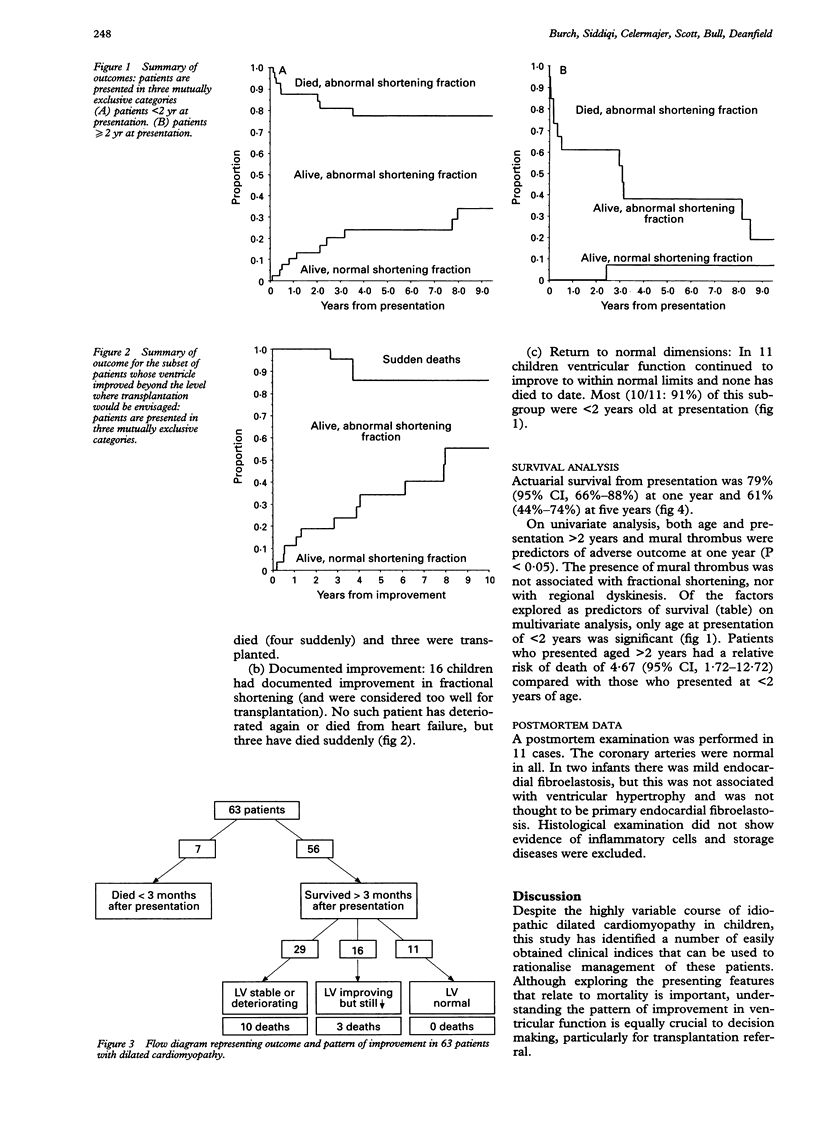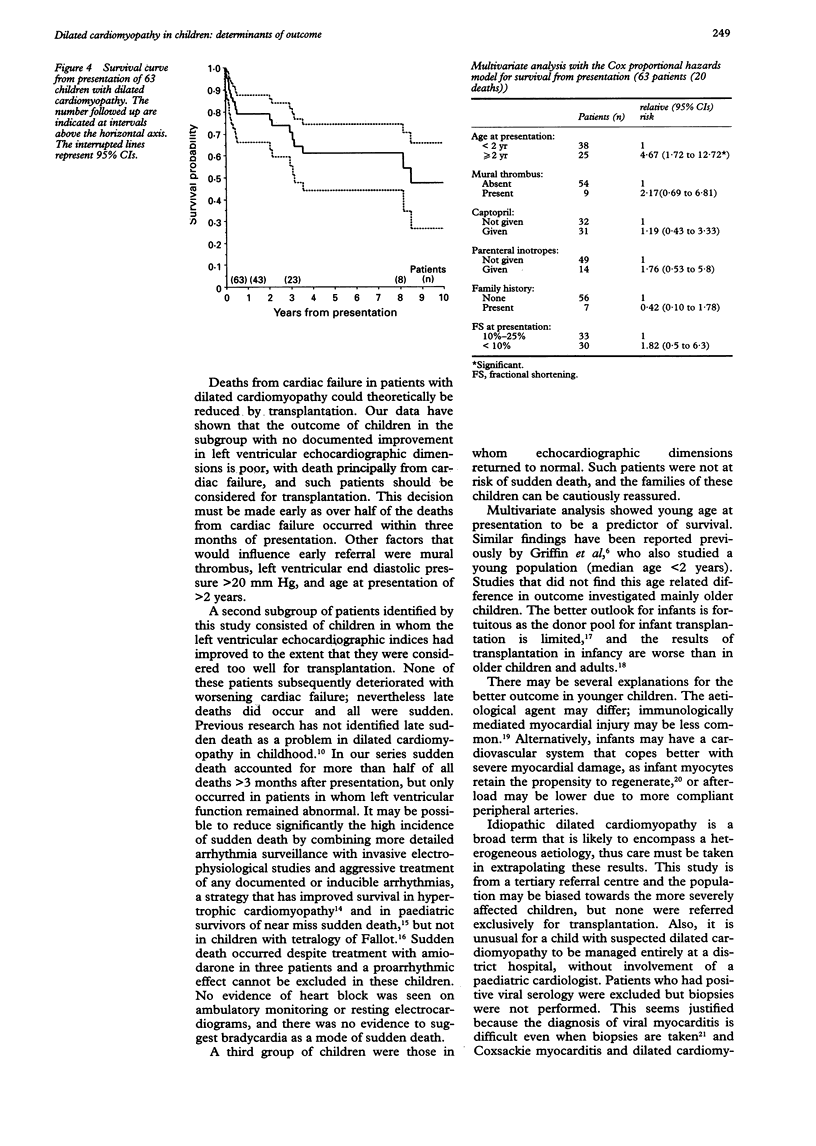Abstract
OBJECTIVE--To determine the outcome of dilated cardiomyopathy presenting in childhood and the features that might be useful for prognostic stratification. SETTING--Supraregional paediatric cardiology unit. DESIGN--Retrospective analysis. BACKGROUND--The natural history of dilated cardiomyopathy in children is not well characterised. Previous studies have shown a variable relation between age at presentation and outcome, and sudden death has been infrequent. METHODS--Retrospective study of 63 consecutive patients with idiopathic dilated cardiomyopathy presenting between 1979 and 1992. Survival curves were constructed by the Kaplan-Meier method. RESULTS--Age at diagnosis ranged from 1 day to 15 years (median 12 months) and follow up ranged from 1 day to 13 years (median 19 months). Actuarial survival from presentation was 79% at one year (95% confidence interval (95% CI) 66%-88%) and 61% (44%-74%) at five years. Univariate analysis showed that mural thrombus, left ventricular end diastolic pressure > 20 mm Hg, and age at presentation > 2 years were predictors of adverse outcome, but on multivariate analysis only age at presentation was significant. Left ventricular echocardiographic indices either did not improve or deteriorated in 36 children (17 of whom died, four suddenly, and three were transplanted), partially improved in 16 (three of whom died, all suddenly), and returned to normal in 11 (all of whom have survived). CONCLUSIONS--Older age at presentation and lack of improvement in systolic function are associated with an adverse outcome, and early transplantation should be considered in these patients. There is a persistent risk of late sudden death in those children in whom echocardiographic dimensions remain abnormal.
Full text
PDF




Selected References
These references are in PubMed. This may not be the complete list of references from this article.
- Akagi T., Benson L. N., Lightfoot N. E., Chin K., Wilson G., Freedom R. M. Natural history of dilated cardiomyopathy in children. Am Heart J. 1991 May;121(5):1502–1506. doi: 10.1016/0002-8703(91)90158-e. [DOI] [PubMed] [Google Scholar]
- Caforio A. L., Bonifacio E., Stewart J. T., Neglia D., Parodi O., Bottazzo G. F., McKenna W. J. Novel organ-specific circulating cardiac autoantibodies in dilated cardiomyopathy. J Am Coll Cardiol. 1990 Jun;15(7):1527–1534. doi: 10.1016/0735-1097(90)92821-i. [DOI] [PubMed] [Google Scholar]
- Caforio A. L., Stewart J. T., McKenna W. J. Idiopathic dilated cardiomyopathy. BMJ. 1990 Apr 7;300(6729):890–891. doi: 10.1136/bmj.300.6729.890. [DOI] [PMC free article] [PubMed] [Google Scholar]
- Chen S. C., Nouri S., Balfour I., Jureidini S., Appleton R. S. Clinical profile of congestive cardiomyopathy in children. J Am Coll Cardiol. 1990 Jan;15(1):189–193. doi: 10.1016/0735-1097(90)90199-y. [DOI] [PubMed] [Google Scholar]
- Fananapazir L., Chang A. C., Epstein S. E., McAreavey D. Prognostic determinants in hypertrophic cardiomyopathy. Prospective evaluation of a therapeutic strategy based on clinical, Holter, hemodynamic, and electrophysiological findings. Circulation. 1992 Sep;86(3):730–740. doi: 10.1161/01.cir.86.3.730. [DOI] [PubMed] [Google Scholar]
- Friedman R. A., Moak J. P., Garson A., Jr Clinical course of idiopathic dilated cardiomyopathy in children. J Am Coll Cardiol. 1991 Jul;18(1):152–156. doi: 10.1016/s0735-1097(10)80233-5. [DOI] [PubMed] [Google Scholar]
- Griffin M. L., Hernandez A., Martin T. C., Goldring D., Bolman R. M., Spray T. L., Strauss A. W. Dilated cardiomyopathy in infants and children. J Am Coll Cardiol. 1988 Jan;11(1):139–144. doi: 10.1016/0735-1097(88)90179-9. [DOI] [PubMed] [Google Scholar]
- Henry W. L., Ware J., Gardin J. M., Hepner S. I., McKay J., Weiner M. Echocardiographic measurements in normal subjects. Growth-related changes that occur between infancy and early adulthood. Circulation. 1978 Feb;57(2):278–285. doi: 10.1161/01.cir.57.2.278. [DOI] [PubMed] [Google Scholar]
- Hingorani A. D. Postinfectious myocarditis. BMJ. 1992 Jun 27;304(6843):1676–1678. doi: 10.1136/bmj.304.6843.1676. [DOI] [PMC free article] [PubMed] [Google Scholar]
- Hofmann T., Meinertz T., Kasper W., Geibel A., Zehender M., Hohnloser S., Stienen U., Treese N., Just H. Mode of death in idiopathic dilated cardiomyopathy: a multivariate analysis of prognostic determinants. Am Heart J. 1988 Dec;116(6 Pt 1):1455–1463. doi: 10.1016/0002-8703(88)90728-4. [DOI] [PubMed] [Google Scholar]
- Huang S. K., Messer J. V., Denes P. Significance of ventricular tachycardia in idiopathic dilated cardiomyopathy: observations in 35 patients. Am J Cardiol. 1983 Feb;51(3):507–512. doi: 10.1016/s0002-9149(83)80089-7. [DOI] [PubMed] [Google Scholar]
- Jin O., Sole M. J., Butany J. W., Chia W. K., McLaughlin P. R., Liu P., Liew C. C. Detection of enterovirus RNA in myocardial biopsies from patients with myocarditis and cardiomyopathy using gene amplification by polymerase chain reaction. Circulation. 1990 Jul;82(1):8–16. doi: 10.1161/01.cir.82.1.8. [DOI] [PubMed] [Google Scholar]
- Keogh A. M., Freund J., Baron D. W., Hickie J. B. Timing of cardiac transplantation in idiopathic dilated cardiomyopathy. Am J Cardiol. 1988 Feb 15;61(6):418–422. doi: 10.1016/0002-9149(88)90297-4. [DOI] [PubMed] [Google Scholar]
- Lewis A. B., Chabot M. Outcome of infants and children with dilated cardiomyopathy. Am J Cardiol. 1991 Aug 1;68(4):365–369. doi: 10.1016/0002-9149(91)90833-7. [DOI] [PubMed] [Google Scholar]
- Olivetti G., Anversa P., Loud A. V. Morphometric study of early postnatal development in the left and right ventricular myocardium of the rat. II. Tissue composition, capillary growth, and sarcoplasmic alterations. Circ Res. 1980 Apr;46(4):503–512. doi: 10.1161/01.res.46.4.503. [DOI] [PubMed] [Google Scholar]
- Olshausen K. V., Stienen U., Schwarz F., Kübler W., Meyer J. Long-term prognostic significance of ventricular arrhythmias in idiopathic dilated cardiomyopathy. Am J Cardiol. 1988 Jan 1;61(1):146–151. doi: 10.1016/0002-9149(88)91321-5. [DOI] [PubMed] [Google Scholar]
- Packer M. Sudden unexpected death in patients with congestive heart failure: a second frontier. Circulation. 1985 Oct;72(4):681–685. doi: 10.1161/01.cir.72.4.681. [DOI] [PubMed] [Google Scholar]
- Silka M. J., Kron J., Walance C. G., Cutler J. E., McAnulty J. H. Assessment and follow-up of pediatric survivors of sudden cardiac death. Circulation. 1990 Aug;82(2):341–349. doi: 10.1161/01.cir.82.2.341. [DOI] [PubMed] [Google Scholar]
- Stuart A. G., Wren C., Sharples P. M., Hunter S., Hey E. N. Hypoplastic left heart syndrome: more potential transplant recipients than suitable donors. Lancet. 1991 Apr 20;337(8747):957–959. doi: 10.1016/0140-6736(91)91581-e. [DOI] [PubMed] [Google Scholar]
- The Registry of the International Society for Heart and Lung Transplantation: ninth official report--1992. J Heart Lung Transplant. 1992 Jul-Aug;11(4 Pt 1):599–606. [PubMed] [Google Scholar]


